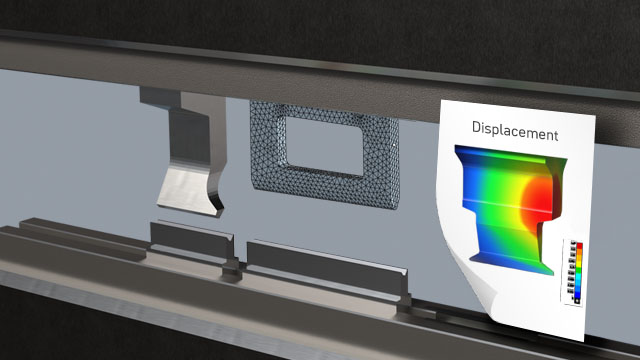Why Festo now relies on Ansys and the partnership with CADFEM for simulation
Alexander Kunz
15.10.2024
Successful changeover for structural mechanics simulations in automation technology
Festo, the globally active automation specialist from Esslingen am Neckar, recognized the advantages of simulation in research and development over 30 years ago. Since then, simulations have been used in many development projects. In 2022, those responsible decided to switch from the previous simulation solution to Ansys and CADFEM. There were good reasons for this.

© Festo
This step was overdue. “From today's perspective, the FEM software should have been changed 10 years ago,” says Dr. Ulrich Böhle, who has been working as a simulation engineer at Festo since 2002 and has been one of those responsible for structural mechanics since 2015.
Instead, Festo opted for continuity, which also has its advantages, such as well-established processes, reliable features and familiar tools. In other words, Festo uses today's proven methods to achieve tomorrow's goals.
But are these methods also sufficient for the goals of the day after tomorrow? As a company that is committed to innovation and invests 7% of its turnover in research and development each year, Festo asked itself this question. Ulrich Böhle and his team uncovered huge potential for working more efficiently and digitally through modernization and the use of synergies. This was 2020 and it was a good time to act.
Simulation in virtual product development at Festo

At Festo, simulations are used both by specialists and by development engineers during the design process. | © Festo
Simulations have played an important role at Festo since the 1980s. As an internal service provider, around 20 simulation experts support researchers and engineers in accelerating development processes. Because design decisions are made faster and with fewer prototypes, this also leads to considerable cost savings. Simulations also help to improve the quality of products and launch innovations, for example by objectively comparing variants.
In addition, all development engineers at Festo are able to carry out simulations independently, either with CAD-related simulation tools or via simulation apps, which, if required, are provided by experts in an in-house app store.
eBooklet: Consistently integrating simulation
In our eBooklet, you will learn how simulation can be integrated holistically into your development processes. Save time and costs and increase your competitiveness.
Get the eBooklet

Never Change a Running System? Or do you?
In principle, Festo was well positioned when it came to FEM simulation. The system was running - but the world was moving faster. What was missing was exactly what Festo actually excels at: the ability to adapt dynamically to new circumstances, developments and objectives.
The internationalization of simulation in the previous system, which led to the team gaining new colleagues in China, not only resulted in additional licensing costs, but also complicated the administrative and technical processes. Although the simulation software, which had been tried and tested for decades, had been mastered, it was no longer able to cope with many of today's requirements.
Tender and Benchmark
Solutions for precisely these problem areas were called for in the requirements catalog, which was presented to the previous supplier and several providers of alternative software products. Ulrich Böhle was in charge of the tender and worked closely with the entire simulation team and other departments (including research, IT, purchasing and testing) to drive the project forward. After all, a project like this can only be successful if everyone who is affected by it is involved. This is because the result has a major impact on the future working environment of those involved, and also because the perspectives, experiences and requirements of those involved are relevant to the decision-making process.
A solution was sought,
-
which covers the entire spectrum of structural engineering applications with the latest technology, flexibly and in a user-friendly way,
-
which can be used at all international locations with a simple and economic licensing and usage model and
-
which can be fully integrated into the existing development architecture, used throughout the entire product development process, and linked to new technologies such as artificial intelligence.
Decision for Ansys and CADFEM

At the end of the intensive evaluation process, the Festo team opted for the Ansys software and the partnership with CADFEM. | © Festo
After an extensive multi-stage evaluation process, in which not only technical benchmarks were assessed but also administrative and economic factors, Ansys emerged as the most suitable solution for Festo.
Powerful, sustainable and user-friendly software
Ansys proved to be a very powerful and user-friendly tool for solving the sample tasks. Plus points were awarded for the rapid pace at which it is being further developed and its openness to individual requirements and integration with other processes and technologies.
Simple and flexible license usage
Ansys offered a license pool for very simple, demand-oriented and location-independent software usage. Internal billing is handled by the IT department at Festo, which relieves the simulation experts working with Ulrich Böhle of these tasks. Ansys can also be installed and used easily and legally by any employee worldwide.
The CADFEM factor
Switching to the new Ansys tool with a different handling and many additional options does not happen by itself. The quick and uncomplicated accessibility of CADFEM engineers, who are familiar with the requirements at Festo and the capabilities of Ansys, has increased the trust necessary for implementation already during the selection process. The wide range of training courses on Ansys offered by CADFEM also ensured that the familiarization with the new system was quick and thorough.
In terms of content and didactics, the eLearning courses from CADFEM are worlds better than anything we have come across in this format before.

Realizing the full potential of simulation
Simulation should be intergrated holistically throughout the entire product development process. Only then can its full potential be realized. How is simulation used?
The calculation works
The initial assessment of the project after 3 years is positive:
-
The acceptance of Ansys among simulation experts is high. The comprehensive and high-quality CADFEM training program consisting of training and eLearning courses that the team took part in contributed to this. The CADFEM Learning Subscription allowed the team to use the program with a high degree of intensity and individuality. The support provided by a designated contact person and regular tech talks to discuss new topics must also be mentioned here.
-
For the development engineers, easy access to the new simulation tools has led to simulation being used much more intensively.
-
By involving other departments, there was broad acceptance and support for the changeover, as evidenced by the IT department at Festo taking over all administrative tasks.
-
Not surprisingly, the changeover would initially come at the expense of the department's productivity (i.e. the number and duration of simulation projects carried out).
-
License costs have become transparent as a result of the new agreement and have fallen as a result of consolidation.
- The cost of internal billing for software usage has been drastically reduced
Ulrich Böhle is pleased. “The entire constellation was an excellent fit! From the powerful software and flexible framework conditions of Ansys, to the Festo team that worked in unison, to CADFEM as a partner who provided us with advice and support to make our entry a success.”

Festo users make intensive use of the wide range of eLearning courses on Ansys. This is made possible by the CADFEM Learning Subscription. | © Festo
About Festo
Festo is a financially independent family-owned company in the field of pneumatic and electrical automation technology with headquarters in Esslingen am Neckar, Germany. 300,000 customers worldwide rely on the drive solutions from Festo in factory and process automation. The focus is always on the most efficient and productive solution. Sustainability and the climate-friendly transformation of production are becoming the most important tasks along the entire value chain. Festo Didactic also offers state-of-the-art qualification solutions for around 56,000 industrial companies and educational institutions.
In the 2023 financial year, the Festo Group generated sales of 3.65 billion euros and has around 20,600 employees at 250 locations worldwide. The company invests over 7% of its turnover in research and development each year.





